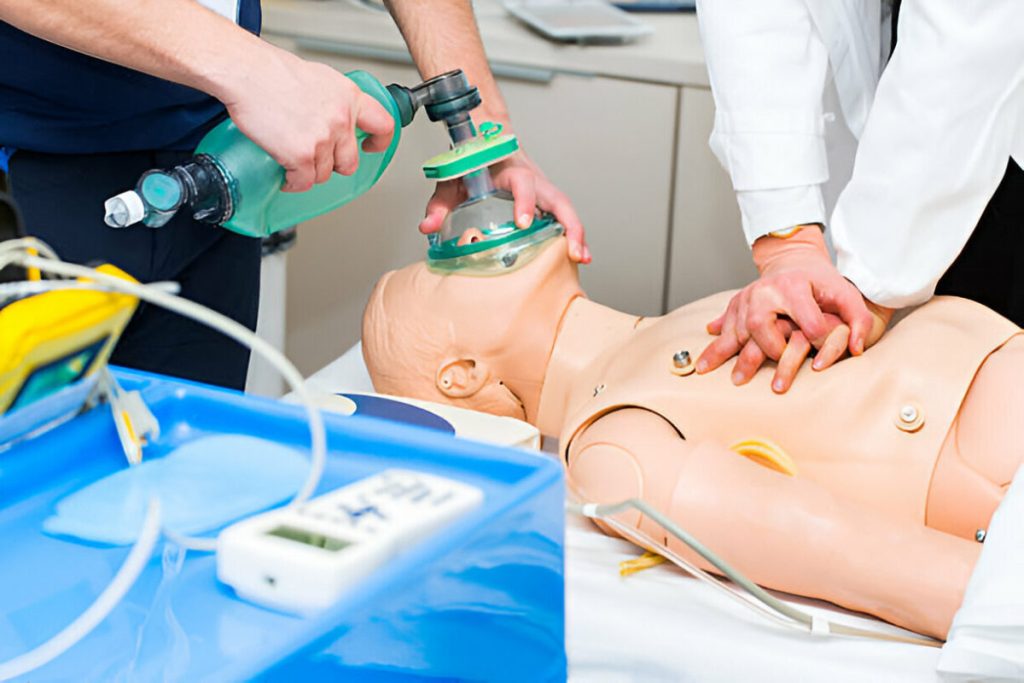Introduction
In emergency healthcare scenarios, effective ventilation can mean the difference between life and death. The One-Person Bag Mask Technique stands as a critical skill for healthcare providers and first responders alike. This fundamental procedure provides oxygen to patients who cannot breathe adequately on their own, maintaining vital oxygen delivery to tissues when every second counts. Despite its importance, studies indicate that many healthcare professionals struggle with the proper execution of this technique, potentially compromising patient outcomes during respiratory emergencies.
This comprehensive guide explores the essential components, proper technique, common challenges, and best practices for mastering the One-Person Bag Mask Technique. Whether you’re a seasoned healthcare professional refreshing your skills or a student embarking on your medical journey, this article provides the knowledge needed to perform this life-saving intervention with confidence and competence.
Understanding the Bag Mask Device Components
Before attempting the One-Person Bag Mask Technique, it’s essential to understand the equipment involved. A typical bag mask device consists of:
- Self-inflating bag (resuscitation bag) – Available in adult, pediatric, and infant sizes, this component automatically refills with air after compression.
- One-way valve system – Prevents exhaled air from re-entering the bag, ensuring patients receive fresh oxygen with each ventilation.
- Face mask – Available in various sizes to accommodate different facial structures, from neonates to adults. The mask typically has a transparent dome to allow visualization of the patient’s lips and secretions.
- Oxygen reservoir – When attached to an oxygen source, this component increases oxygen concentration delivery from approximately 21% (room air) to as high as 90-100%.
- Oxygen tubing – Connects the bag mask device to an oxygen source when available.
Familiarizing yourself with these components before an emergency arises ensures you can quickly assemble and utilize the device when seconds matter most.
Preparation for One-Person Bag Mask Technique
Proper preparation significantly influences the effectiveness of the One-Person Bag Mask Technique. Follow these preparatory steps:
Select the appropriate mask size that covers from the bridge of the nose to the cleft of the chin without extending beyond these landmarks. An improperly sized mask compromises the seal, reducing ventilation effectiveness.
Position yourself at the head of the patient whenever possible. This positioning provides the optimal angle for airway management and mask seal.
Ensure the patient is positioned on a firm, flat surface with their head in a neutral or slightly extended position, avoiding hyperextension or flexion that could obstruct the airway.
Connect the bag mask device to supplemental oxygen if available, setting the flow rate between 10-15 liters per minute to maximize oxygen delivery.
Remove any visible obstructions from the patient’s mouth, including dentures that are loose, vomit, or foreign bodies that might impede ventilation.
This methodical preparation establishes the foundation for the successful implementation of the One-Person Bag Mask Technique in emergency scenarios.
Step-by-Step One-Person Bag Mask Technique
Executing the One-Person Bag Mask Technique properly requires precise hand positioning and attention to detail. Follow these sequential steps:
1. Establish the C-E Grip
The modified C-E grip forms the cornerstone of the One-Person Bag Mask Technique:
- Position your non-dominant hand on the mask, forming a “C” shape with your thumb and index finger around the connector portion of the mask.
- Place your remaining three fingers in an “E” formation along the mandible, lifting upward to open the airway without pressing on the soft tissues under the chin.
- Apply downward pressure with your thumb and index finger while simultaneously lifting the jaw upward with your other fingers, creating a tight seal between the mask and the patient’s face.
2. Maintain Proper Head Position
While maintaining the mask seal with your non-dominant hand:
- Ensure the patient’s neck remains in a neutral or slightly extended position (sniffing position).
- Avoid excessive head tilt, which may close the airway, particularly in patients with suspected cervical spine injuries.
- Continuously reassess head position throughout the ventilation process, as patient movement can alter airway patency.
3. Deliver Effective Ventilation
With your dominant hand:
- Compress the bag at a controlled rate, delivering each breath over 1 second.
- Observe for visible chest rise with each ventilation, the primary indicator of effective air delivery.
- Allow complete recoil of the bag between ventilations to ensure it refills completely.
- For adult patients without an advanced airway, deliver one ventilation every 5-6 seconds (10-12 breaths per minute).
4. Coordinate with Chest Compressions During CPR
When performing the One-Person Bag Mask Technique during cardiopulmonary resuscitation:
- Maintain a 30:2 compression-to-ventilation ratio in adults when no advanced airway is present.
- Deliver each ventilation during the brief pause after each set of 30 compressions.
- Resume compressions immediately after delivering the second ventilation to minimize interruptions.
Mastering these steps through regular practice ensures you can perform the One-Person Bag Mask Technique efficiently during high-stress emergency situations.
Common Challenges and Troubleshooting
Even experienced healthcare providers encounter challenges with the One-Person Bag Mask Technique. Recognizing and addressing these obstacles improve ventilation effectiveness:
Inadequate Mask Seal
An imperfect mask seal causes air leakage, reducing the volume delivered to the patient. If you notice air escaping:
- Readjust your C-E grip, ensuring even pressure distribution around the mask perimeter.
- Consider using a two-handed technique with a second provider squeezing the bag if available.
- For patients with facial hair, apply additional pressure or consider using a water-soluble lubricant to improve the seal.
Airway Obstruction
If you encounter resistance to ventilation or notice absent chest rise:
- Reposition the patient’s head, adjusting the degree of extension or considering a jaw thrust maneuver.
- Inspect for and remove any visible obstructions in the mouth.
- Consider inserting an oropharyngeal or nasopharyngeal airway if appropriate for the patient.
Gastric Distention
Excessive air entering the stomach can cause:
- Regurgitation and aspiration risk
- Diaphragm elevation, restricting lung expansion
To minimize gastric distention:
- Deliver slower ventilations with only enough volume to achieve visible chest rise.
- Avoid excessive pressure when squeezing the bag.
- Consider cricoid pressure application by a second rescuer if available (though this remains controversial in current guidelines).
Recognizing these common challenges enables you to adapt your technique for optimal patient ventilation regardless of the circumstances encountered.
Improving One-Person Bag Mask Technique Through Practice
Like any clinical skill, proficiency in the One-Person Bag Mask Technique requires dedicated practice. Consider these approaches to skill enhancement:
Utilize simulation training with realistic mannequins that provide feedback on ventilation volume and effectiveness. Many modern training devices can measure delivered tidal volumes and mask leak percentages.
Practice regularly, not just during certification courses. Studies indicate that bag mask ventilation skills deteriorate significantly within six months without refresher training.
Record your practice sessions when possible, allowing for self-assessment of hand positioning, ventilation timing, and overall technique.
Participate in peer-to-peer evaluation, where colleagues provide constructive feedback on your technique from perspectives you might not notice yourself.
Consistent practice transforms the One-Person Bag Mask Technique from a challenging procedure into a reflexive skill you can deploy confidently during emergencies.
Special Considerations for Different Patient Populations
The One-Person Bag Mask Technique requires modifications for different patient populations:
Pediatric Patients
When ventilating pediatric patients:
- Select an appropriately sized mask that covers from the bridge of the nose to the chin without compressing the eyes or extending beyond the chin.
- Position the head in a neutral alignment, avoiding the extension often used for adults.
- Deliver smaller tidal volumes, just enough to cause visible chest rise (approximately 4-6 ml/kg).
- Ventilate at a faster rate than for adults: 12-20 breaths per minute.
Edentulous Patients
For patients without teeth:
- Consider removing dentures if they’re loose or ill-fitting, as they may complicate the mask seal.
- If dentures fit well, leaving them in place often provides better support for facial structures and improved mask seal.
- Use additional padding at the cheeks if necessary to fill voids and improve the mask seal.
Facial Trauma Patients
When ventilating patients with facial trauma:
- Consider alternative airway management techniques if the mask seal is impossible.
- Position the mask to avoid direct pressure on injured areas while maintaining the best possible seal.
- Be prepared for increased difficulty and potentially inadequate ventilation requiring advanced airway intervention.
These population-specific considerations ensure you can adapt the One-Person Bag Mask Technique to meet the needs of any patient requiring ventilatory support.
Conclusion
Mastering the One-Person Bag Mask Technique represents an essential skill for healthcare providers involved in emergency care. Through understanding proper equipment selection, meticulous attention to hand positioning, and regular practice, you can confidently provide effective ventilation to patients in respiratory distress.
Remember that proficiency requires ongoing practice and skill maintenance. The techniques described in this comprehensive guide provide the foundation, but only through consistent application and refinement will you truly master this critical life-saving intervention.
Call to Action
Don’t wait until an emergency to develop competency in the One-Person Bag Mask Technique. Enroll today in professional training through CPR Nashville, an American Heart Association training site offering stress-free, hands-on certification courses in Nashville. Whether you need BLS certification Nashville or CPR certification Nashville, our experienced instructors provide personalized guidance to ensure you master these critical skills.
Contact Best CPR in Nashville today to schedule your certification or renewal course and gain the confidence to perform life-saving interventions when they matter most. Your proficiency in techniques like One-Person Bag Mask ventilation isn’t just a professional requirement—it’s a skill that saves lives.





